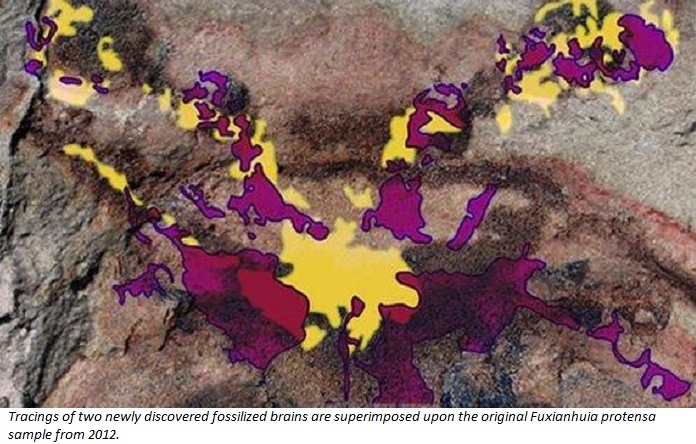Half-Billion-Year-Old Brains Preserved in Fool`s Gold

Researchers led by Nicholas Strausfeld, a neuroscientist at the University of Arizona, first discovered fossilized brains this old in 2012, but only reported on one specimen. Now, Strausfeld and his colleagues have analyzed seven more fossils and discovered bits of brain in each. They reported their findings online in the journal Current Biology on Oct. 29.
The new paper confirms that F. protensa had a surprisingly complex three-part brain, split into sections called the protocerebrum, deutocerebrum and tritocerebrum. This is similar to the brains of today`s modern crustaceans and insects, which, like shrimpy little F. protensa, are arthropods. [Fabulous Fossils: Gallery of Earliest Animal Organs]
The research also clarifies how soft tissue like a brain could survive for half a billion years in fossil form. The brain fossils appear as black shadows on otherwise yellowish fossils, the researchers wrote in their paper. This black stain is rich in carbon, while the surrounding fossilized tissue is heavy in iron. Some of these carbon brain "films" are overlaid with pyrite (commonly known as fool`s gold).
To fossilize, the ancient arthropods would have to have been buried very rapidly — possibly by an underwater mudslide, Strausfeld and his colleagues wrote in an article published in the journal Philosophical Transactions of the Royal Society B on Monday (Nov. 9). The fine-grained sediments would have sealed out oxygen and pressed water out of the arthropod brains, a process called "dewatering," reducing them to the carbon-rich film seen in the fossils today.
Sulfate-eating bacteria in the sediment could then chow down on the organic material, excreting a compound called bisulfate where the brain used to be. This bisulfate would have then reacted with iron in the surroundings to create pyrite deposits.
The fact that the brains could be preserved in this way suggests that the cells of the F. protensa nervous system were tightly packed and dense. This density would have allowed the brains to survive the weight of the mud that buried the animals.
"Dewatering is different from dehydration, and it happens more gradually," Strausfeld said in a statement. "During this process, the brain maintains its overall integrity leading to its gradual flattening and preservation. F. protensa`s tissue density appears to have made all the difference."
Incredible fossilization is common in the shale of Yunnan province, where the F. protensa specimens were found. In December 2013, Strausfeld and his team reported in Nature Communications that they`d discovered an F. protensa specimen with a fossilized circulatory system. The digestive tracts of these ancient animals were also preserved in stone.















































